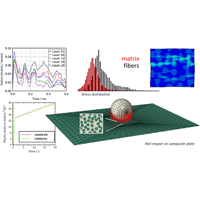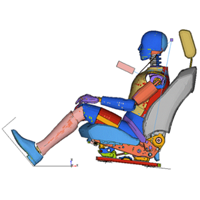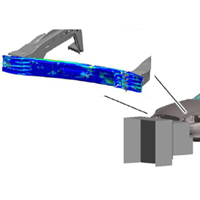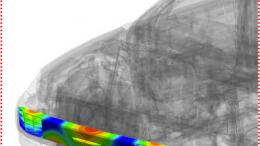
Crash and Impact analysis for Structural Engineering using Digimat composite material modeling platform
Many real-world engineering situations involve severe loads applied over very brief time intervals. While testing is crucial to analyze these types of loading scenarios, it can be expensive and sometimes economically infeasible to conduct physical tests when the cost of each prototype is prohibitively high. Moreover, data from a single physical test can be insufficient and companies cannot afford to conduct several of them for more detailed information.
In the steady quest for lightweighting solutions, continuous carbon fiber composites are becoming more approachable for design, now not only used in the aerospace but also the automotive industries. Carbon Fiber Reinforced Plastics (CFRP) have been used for a long time in Aerospace for primary structure components and they are now being integrated into car body structures, used for their high stiffness and strength and low weight.
The material properties of composites structures (chopped or continuous fibers) are much more complex than metal, especially with respect to failure. Digimat allows to choose the correct failure modeling according to the type of micro-structure definition. Digimat can deal with both continuous and chopped fibers.
Design composite structural parts for crash and impact analysis using Digimat:
- Deformation and damage analysis
- Material failure predictions
- Drop and crushing testing
- High-speed and hypervelocity impacts
- Highly nonlinear, transient dynamic forces
- Explosive loading and forming
Application for Crash and Impact in the industry with Digimat modeling plateform:
- Aerospace and Defense:
Bird strike, damage tolerance, ballistic impact, crashworthiness, ice impact. - Automotive:
Front crash (full car), airbag deployment, side pole crash, pedestrian safety, hood/door slam, seat design, front end carrier, stone impact, etc . - Electronics:
Drop test, etc. - Energy:
Wind turbine blade stability, bird impact, pipe impact, etc.
With DIGIMAT unidirectional composites can be investigated in deep detail on the microscopic level. This brings an additional scale to multi-‐scale modeling enabling failure prediction beyond the ply level of the composite..
-Dr Laurent Adam, R&D Director.
e-Xstream engineering
| Industries:
Aeronautics Material:CFRTP Overview:Bird Strike represents a significant threat to aircraft safety. When occurs, integrity of the structure has to be preserved. The study focuses on the impact against the underbelly fairing made of Continuous Fiber Reinforced Thermo Plastic. The simulation is done using Digimat CAE coupled with Radioss. In this case, Digimat Technology allows to define micro-mechanical material properties for each constituant of the UD but also to introduce specific failure criteria for each phase. Maximum principale strain is used for the resin and maximum stress used for the reinforcement. Results yields to a better and accurate prediction of the failure scenario at the sub-ply level during the impact. |
  DOWNLOAD DOWNLOAD |
| Industries:
Aeronautics Material:CFRTP Overview:In this study, effect of hail impact on a laminate structure is studied. The material properties are defined at the micro-scale level, taking into account the plasticity of the epoxy resin and the transversely isotropic behavior of the carbon fiber. Failure is then analyzed at the phases level with appropriate failure indicator for each. The accumulation of plasticity due to the cycling loading (hail impact) can be, in a second step, investigated in detail. |
  DOWNLOAD DOWNLOAD |
| Industries:
Automotive Material:Short fiber reinforced plastic Overview:To help future vehicles to respect worldwide environmental regulations, a new seat structure has been designed in short fiber reinforced plastic instead of usual metal. Digimat capability to take into account the effect of the manufacturing process on the mechanical behavior of the structure has been helpful to design this new seat. Map the fiber orientation field from the injection mesh onto the structural FE mesh has led to an accurate prediction of the crash performances in terms of maximum force, location of failure and crack propagation compared to experimental tests. The Digimat technology has allowed to reach a reduction target of 35% on the weight and 50% on the number of parts while securing the safety performance’s validation of the seat. |
  DOWNLOAD DOWNLOAD |
| Industries:
Automotive Material:Short fiber reinforced plastic Overview:The full solution offered by the Digimat platform has been applied on the front crash simulation of a bumper beam made in short fiber reinforced plastic. On the accuracy side, an elastic viscoplastic material model has been combined with the fiber orientation field obtained previously by the injection simulation to simulate the front crash at 2 different levels: the part level and the full car level. On the cpu time side, the use of the hybrid calculation mode on Digimat in addition to an optimization of the FE job setting has led to show this advanced multi-scale technology is fully applicable in the automotive industry taking into account its constraints in terms of development timelines. |
  DOWNLOAD DOWNLOAD |



